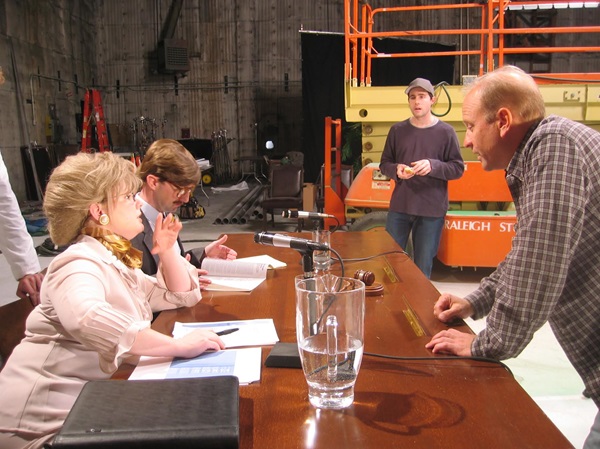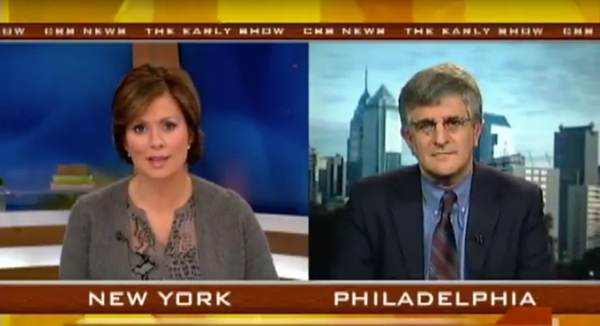Randy Olson is a scientist-turned-filmmaker who left a tenured position as a marine biologist in the 1990s to go to film school and pursue a career in Hollywood. Since then, he’s made several films, including Flock of Dodos: The Evolution-Intelligent Design Circus, which aired on Showtime for more than two years. He’s also the author of Don’t be Such a Scientist: Talking Substance in an Age of Style, the second edition of which will be published in early 2018.
His more recent book, Houston, We Have a Narrative: Why Science Needs Story, is the basis of Olson’s Story Circles training, which he’s deployed at the National Park Service (NPS), the U.S. Department of Agriculture, Genentech and other scientific institutions. A recent NPS report on preserving cultural sites used Olson’s “and, but therefore” (ABT) narrative template to tell stories about what’s happening to protected sites around the country as the climate changes.
I reached Olson over the phone at his home in Los Angeles, California. Our conversation has been edited for length and clarity. And in full disclosure, I’ve worked on one of Olson’s trainings and he compensated me for my time and travel costs.

Olson, far right, directing “Senate Hearing on Coral Reef Decline,” a short satirical film starring Melissa McCarthy and Jim Rash.
You bridge these two very disparate worlds. What does Hollywood understand about communication that science doesn't?
Hollywood has been the incubator of the practical side of narrative in our society for a century. People have lived entire lives here based on one thing: their ability to use narrative. As a result, they have boiled narrative down to its ruthless, shortest, most concise, most powerful, most punchy, most effective elements.
In communication, there's the structure and the content. Hollywood has got the strength in the structure, it's lacking content. Academics are infatuated with their content, but lack appreciation for structure.
So what does moving from content-based to structure-based communication look like?
Right now, I'm working with the American Association for the Advancement of Science’s (AAAS) Invention Ambassadors. These are people who are used to talking to other people in the science world about their inventions. Now they're talking to the educated general public, including other professionals in DC. The challenge is to take these presentations they've been giving for years to an audience that wants to know about the specifics of their invention and instead talk about being an inventor in today's world. That means prioritizing not the content, but the structural story elements and looking for human stories people can connect with.
How did you start to develop this idea of an “and, but, therefore” narrative template? I think when people hear me describe the “ABT” they often think it can’t really be that simple. But it’s really a powerful concept.
I managed to at age 38 basically do a brain transplant experiment. I pulled my brain out of academia and into the narrative world of Hollywood. And I’m a whole lot better at narrative today than I was then. But that said, I can’t tell stories the way the great Hollywood screen writers can. It's been a journey for me to grasp what they tried to tell us the first day of film school, which is that the most important thing you’re going to learn here is story.
When I made Flock of Dodos, we shot it, we glued it together, and for six weeks, the movie had virtually no narrative structure to it. It was just a bunch of information. It was, “and, and, and.” Finally, I came up with a very simple story to structure it around, which was the journey of a guy trying to figure out what’s behind this controversy. Everything transformed overnight. That was the definitive proof for me of how it works, but I still didn’t have any ability to articulate what I’d gone through in that transformation.
In 2011, I saw a documentary about the making of South Park and the creators, Trey Parker and Matt Stone, talked about this very simple technique they use. They call it the rule of replacing. They go back into their script and every time they encounter the word “and” ask themselves if they can replace it with a “but” or a “therefore.” Every time they can, the storytelling gets more interesting.
I never heard storytelling put that simply or more precisely. And when I dug deeper I found my way to legendary screenwriting instructor Frank Daniel whose course I had at USC the year before he died. He is the first one I can find to call attention to the power of these words for narrative structure.

When I first reviewed your book, I showed you a Paul Offit interview I often use in workshops and you summarized one of his “ABTs” very neatly: My wife was giving a child a vaccine AND right before she gave him the shot, the child had a seizure BUT if the shot had come first, the parents obviously would have thought the shot caused the seizure THEREFORE we can’t trust anecdotes, we have to trust data and science when it comes to vaccine safety. Later I learned that this is a story Offit uses constantly. How do you work to train people on communication and help them identify concrete stories like that?
The Groundlings say improv is like a muscle; you can’t get good at in one day. With improv you’ve got be doing it over and over again, conditioning yourself. Increasingly, I’m of the opinion that one-day workshops send the message that you can get really good at it with some tips and tools. Not gonna happen. So we do ten one-hour sessions. It’s intuitive, not intellectual. It begins with a one-day workshop we call a demo day and we pull in up to 50 people. At the end of the demo day, they sign up for Story Circles, if they’re serious about doing this training. And each Story Circle consists of five to six people who work on storytelling together with my coaching each week.
You’ve also pointed to a 1999 speech that Michael Crichton, the author of Jurassic Park and all these other mega-hits, gave to AAAS. And it’s such a shame that Crichton would go on to become very critical of climate science, because he did have a lot of valuable things to say about how we do communication in science. What stood out to you about his speech?
He really was the smartest brain for the science world when it came to mass communications and they didn’t listen to a thing he said. It was a blueprint before the anti-science movement had really taken off about how to deal with it. He said the science world should figure out key spokespeople for different disciplines. He also said the information era will be dominated by those who manipulate the media. And academics say they don’t want to get involved in manipulating the media. But look deeper. Media is narrative. That’s what drives media. You don’t get on TV if you don’t have a strong narrative quotient or narrative index to what you’re doing. If you want to go on and on about your issue, you’ll wind up on PBS where they’ll let you drone on and on and nobody watches you, but if you want to be on the other networks, you have to understand concision and structure to boil your message down under those constraints.
These aren’t options. These are obligatory aspects of communications. Why the science world thinks it gets special dispensation and can somehow communicate differently is just mind-boggling.
So who would you point to working today in science communication that’s doing it well?
“Science communication” is almost a contradiction in terms. In a lot of ways, there’s no such thing as “science” communication. There’s just communication. These principals are universal. If you don't have deep intuition for narrative, you're never going to communicate effectively.
I can’t point to anything in the science communication world, but I can point to HBO Real Sports with Bryant Gumbel. Month after month they tell amazing stories that have nothing to do with sports, but have to do with human beings. These stories can be told just as well in the science world, but it’s never been the instinct. Science folks love science and so they focus on the science. They appeal to the gee-whiz crowd, but don’t broaden anything beyond the science world.
But here’s the catch. Narrative has been around for at least 4,000 years. These are core, inviolable principles. It is the landscape for communication. Yet science is smart. Which means scientists should be teaching the world how to communicate, rather than still trying to figure it out for themselves.
Aaron Huertas will be a speaker at the Student Research Conference on November 11 in Raleigh, North Carolina. He is the founder and principal of Science Communication Media, a consulting firm in Washington, DC.